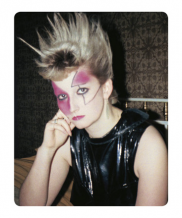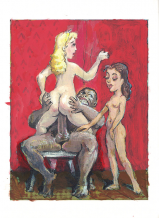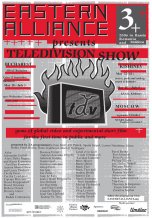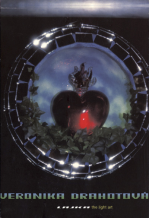| Zeitschrift Umělec 2002/3 >> One Small Diversion | Übersicht aller Ausgaben | ||||||||||||
|
|||||||||||||
One Small DiversionZeitschrift Umělec 2002/301.03.2002 Rafał Jakubowicz | Polen | en cs |
|||||||||||||
|
"In early September the Polish newspaper Gazeta Wyborcza published a text by Kuba Wandachowicz of the band Cool Kids of Death.1 In this manifesto, entitled “Generation Nothing,” he defines in specific terms the Polish situation in which he and his peers currently live. They are young “intellectuals,” representatives of the generation born in the mid-1970s, a generation that, as Wandachowicz puts it, lost its “fight with freedom.” About the same time I also happened to see an exhibition at Gallery Raster entitled Pomocy! (Help!)2 by Oskar Dawicki, an artist whose work I wasn’t familiar with. Was this a coincidence? In any case, it seemed to me that these two undertakings (the manifesto and the exhibition) would make for a perfect concoction.
Overall the manifesto was no revelation. The author sketched out and formulated issues that most were familiar with but thought better left unsaid. Perhaps that’s why Wandachowicz’s text caused an avalanche of polemical articles, commentary of all kinds, letters and opinions. Responses were extreme. Rarely does any article get such a reaction. I learned about his manifesto later from my friends. Cut outs from the paper circulated around town from hand to hand. I got hold of it a week after it was published. “It’s a question of our […] face, which is often one of the defeatist sick of life, the simpleton, the hip hopper, the employee of an ad agency (the symbol of social preference understood in modern terms), the dope smoker, the pseudo kibitzer, the alcoholic […], the journalist, the guy in the tracksuit, the bank clerk, the right-wing youth organizer who gets his faith in the administrative power of politics from pre-war publications… […] The generation I call ‘Generation Nothing’ is all the more distinct for, at an age when other generations were experiencing the repression that was somehow connected to limiting its liberties (wars, totalitarian regimes), today’s young people are losing the fight with freedom that others won in wars.” How many people have abandoned or suppressed their ideals in favor of working in advertising agencies, complimenting the lowest tastes of clients and superiors, Wandachowicz asks. Indeed, how many? Everyday life in an advertising agency is tiring. Artists working in advertising usually experience ambiguous emotions. On the one hand, they accept the conformist’s cool posture, maintaining that making art is utterly useless, whatever that means. (If they mean the status of the artist in society, they’re probably right.) On the other hand, they are troubled by certain defeat. They often suffer from various types of depression. Brand name products don’t help much; everything they gain is refunded with resignation. Young art school graduates draw a line in order to get by — as long as they can — between the two spheres of their activities: “making art” and “making money.” Many fool themselves, saying that it’s only temporary work for just a few months, half a year at most. They hope to pay off debts, and then they will return to their original work. Maybe they can make a bit more money so they can buy a new computer and then a digital camera. Time passes. Needs are on the rise while illusions fall. Ultimately “making money” inconspicuously becomes “producing money.” If you live off advertising, you still have time for art, but mostly only on the weekends. Tit for tat. The symbiosis is illusive. Artists working in agencies display schizophrenic behavior. Problems they deal with in “art” are usually far from themes “advertising” is concerned with. One opposes the other. In the end, one forces the other out. And it is usually art that is forced out. Does it have to be this way? “It appears that along with our freedom, which we obtained when we were somewhere between elementary and high school, the number of our expectations and requirements also changed. Older people wanted money and freedom; we were mainly interested in freedom (such was the essence of our age in its typical youthful romanticism). But today we, and the younger generations, are only interested in money. […] The career hunt, which began at the beginning of the 1990s when advertising agencies sprang up like mushrooms after the rain, employing great numbers of art school graduates and those with a higher than average IQ, brought a dangerous deficit of worldviews,” writes Wandachowicz. Gdańsk gallery Łaznia is currently working on an exhibition entitled Guide to Life, which will show the conditions in which artists in Poland live and work (and how the state displays total indifference). The show will touch on an issue often suppressed. The opening of the exhibition is planned for 13 December 2002 (the same day the Polish government declared Martial Law in 1981). This is no coincidence and provokes thought — especially in the city of Gdańsk. Did the people who fought the regime in the 1980s really long for the current system? The ideological priorities of that time have been replaced by the similarly cruel and unscrupulous economic priorities of today. Artists fought for freedom in various ways in the 1980s. Under conditions stimulated by business interests, artists now do not believe their freedoms will ever be negated and readily come up with new advertising slogans. Rarely does anyone raise objection to the conditions in which artists are living in today’s market economy. And there are things to object to. “The freedom Poland won after 1989 at a certain moment became a word that ended all discussion. The expression ‘we’re free’ increasingly meant that we have the right not to know what we want to do in our lives, that we have the right to live from day to day, to enjoy all the things we can buy with our hard-earned money. […] On the one hand, we’re overwhelmed by freedom; we woke the optimism up within us (or rather, it was woken up in us) only to face the grim prospect of unemployment and the necessity to revere the lowest instincts of the new idol — the impersonal Client. […] Those who, in theory, should honor our intellectual and spiritual background now participate in conquering the world alongside those with the lowest social taste, because this is the only way they can make a living,” writes Wandachowicz. Łaznia sent out a questionnaire to artists. Question no. 26 asked what industry artists were working in. Choices included, C. manual technical labor, D. entertainment, E. advertising. Let’s stick to advertising. It’s now common knowledge that in order to make a living most artists end up working in advertising agencies. Is it at all possible to “work in advertising” and independently “make art”? Maybe, but it certainly requires a healthy dose of obstinacy and considerable self-denial. In any case it is much harder to “make art” while “working in advertising,” or to use work from “advertising” in “art” (and avoid farming the muddy field of the nebulous “art of advertising”). The artwork of Oskar Dawicki is relevant in this context. Specifically his September exhibition Help!, which took place in Gallery Raster in Warsaw. The artist hung color prints and advertising posters on the walls of this smallish gallery. The posters were original and rather ugly (ineffective) from the point of view of esthetics and advertising. One really didn’t feel like studying them, so first observations tended to be fairly hasty. Under other circumstances very few people would have notice them. What was this all about? If the posters were, say, painted over, the game would be much more decipherable. But no, they were not painted over. Dawicki didn’t do anything with them. Nothing except for showing them in the gallery. But why the gallery, why not in the places for which they were designed? The posters were accompanied by small cards/maps in which one detail was circled with a red marker, an indicator telling us where to search. The maps were the key. What the viewer was supposed to look for was so miniature, so tiny, that help was needed. Fortunately a magnifying glass was at hand specifically for this purpose. Armed with the glass, visitors were free to begin their examination. The artist forced viewers take a closer look at a detail in the work that most people would have otherwise ignored. And patience was rewarded. After a moment of concentration a detail was found on the poster identical to the one on the map. A face. Ah, so now we know that we’re looking for microscopic faces of the artist, signatures perfectly masked within the ads. Suddenly one poster — I don’t recall what it was promoting (which is typical) — revealed a couple hugging. One picture of a boy wearing jeans also had Oskar Dawicki’s face hiding on the company label stitched to the pants. Would anyone have paid attention to a company label outside of the gallery context? Each new revelation, even though the viewer knew what to look for, was as surprising as it was entertaining. With thoughtfulness Dawicki made use of his work in an advertising agency, something most artists would have passed over in silence. It’s a rather embarrassing theme. The idea might have come from the piercing feeling of absurdity inherent in the routine work. The artist “made art while working in advertising.” A diversion? Sabotage? Gesture of despair? He dared to start the individual partisan war that many frustrated graphic designers might have contemplated. He was paid for his work in the advertising agency yet he secretly (without permission) worked on his own art project. From the point of view of the agency, he has done it damage. His work spanned a period of two years. Test of perception? Mal-versation? Is he compromising the company or paying homage? Clients paid for a product and got an art project in return. Perhaps the “impersonal client” should be happy (that he bought a work of art so cheaply). But it is unlikely that anybody in the agency noticed a thing. It is possible that to this day not a soul in the company is aware the project even exists, including those who placed and accepted the order. What would their reaction be if they found out about it? Do heating equipment producers have a sense of humor? Would they show generous understanding? Dawicki clearly, radically and comprehensibly commented on the reality in which he lived as an artist and employee of an advertising agency. The artist outsmarted the employer and clients and what’s more, in one sharp move, he managed to get his own customers. So working in advertising doesn’t necessarily have to be boring. It’s just a stereotype. Moreover, working in an agency doesn’t necessarily have to mean resignation in art. If given the opportunity, personal art projects may even be realized against all the odds (while using a company computer). Slightly altered promotional materials (prints and posters) become something else. What? Exactly what they are depends mainly on whether the artistic effort has been noticed. Dawicki made a subtle “shift.” Nothing is in its proper place: a gallery is not a suitable context for showing ads and ads are not designed for the placement of “foreign” content. So where exactly is their real “place”? Video footage in which almost nothing happens also accompanied the exhibition. Occasionally somebody would say, “Hello, hello, I’m here.” But nobody was there. It was just this monotonous voice and monotonous camera work. Long shots showing a room and a table. The room was messy with many things scattered around. And the voice again, “Hello, hello, I’m here.” But we never see the owner of the voice. Suddenly you spot a small shape in sunglasses lying on the table. The person was not actually in the shot but the sensitive eye could see his reflection. Dawicki’s exhibition Help! could be interpreted in a number of different ways. The more ambitious might write about the “corrosion of identity” or other similar, not so transparent “problems of contemporary man” basing their theories on the skillful formulations of leading postmodernists. Just think how many quotations and arguments could be used here! Ah, the Derrida and Baudrillard! Let’s look at the exhibition in the context of Dawicki’s earlier works concerning contemporary issues. In one he had his portrait painted by street artists, and in another he hired a private eye to gather information on him. Dawicki’s work is about the search for identity. Is there a place today for something as archaic as individuality? Isn’t this a cumbersome burden we should shed in order to increase work efficiency? The cool posture has become fully functional and generally accepted as a replacement for individuality. Presentation, self-evaluation and the perfectly learned image are crucial. Dawicki plays a game with himself, his identity, self-evaluation and his situation — the situation of an artist trying to create his own personality — and at the same time he sees himself as a graphic designer working in advertising. Which of these views is more authentic? Perhaps neither. And perhaps authentic is not the right word. Who is the “real” Oskar Dawicki? Perhaps the “real” Oskar Dawicki doesn’t even exist. Is it the face hiding in the advertising prints? Is it a face recorded on camera as a reflection on a teacup, a spoon or a faucet? And a whisper like the sound of a broken toy: “Hello, hello, I’m here.” Isn’t this enough? Wandachowicz’s bottom line is that we — the generation of the 1970s — have sold our identity. We have sold it for an exceptionally low price. The picture of reality he has outlined is filled with sadness. Dawicki calls for the search for one’s own identity. It could be worth listening to this call, though the chance of success is small. However the search is necessary even if there is no chance at all. Perhaps the effort itself will be the victory. It seems that Dawicki realizes the hopelessness of the gesture he has made, which makes it all the more significant. The artist plays a game with viewers, their habits, expectations, habits of perception and with the exhibition as an independent convention. The reality of the free market hands the steering wheel over to the impersonal Client, without taking the Client’s character or goals into consideration. Conforming to the “impersonal client,” who sets the rules of the game, is a requirement for playing the game of social roles (manager, copywriter, artist, art director). One is only free to choose; almighty economic factors set limits to everything else. There’s no place for artists who wish to work on the basis of the modern paradigm. Dawicki’s projects should be perceived as an act of theater (or rather a show) entitled “Does Dawicki Really Exist?” In fact, nobody knows whether he exists. For the time being we only know that he’s been “spotted” on hundreds (perhaps thousands) of ads. And that’s something in its own right. Notes: 1. Kuba Wandachowicz, Generation Nothing, Gazeta Wyborcza, 4 September 2002, pp. 11–12 2. Oskar Dawicki, Pomoc!, Gallery Raster, Warsaw, 9 September — 18 October 2002 "
01.03.2002
Empfohlene Artikel
|
|||||||||||||
|
04.02.2020 10:17
Letošní 50. ročník Art Basel přilákal celkem 93 000 návštěvníků a sběratelů z 80 zemí světa. 290 prémiových galerií představilo umělecká díla od počátku 20. století až po současnost. Hlavní sektor přehlídky, tradičně v prvním patře výstavního prostoru, představil 232 předních galerií z celého světa nabízející umění nejvyšší kvality. Veletrh ukázal vzestupný trend prodeje prostřednictvím galerií jak soukromým sbírkám, tak i institucím. Kromě hlavního veletrhu stály za návštěvu i ty přidružené: Volta, Liste a Photo Basel, k tomu doprovodné programy a výstavy v místních institucích, které kvalitou daleko přesahují hranice města tj. Kunsthalle Basel, Kunstmuseum, Tinguely muzeum nebo Fondation Beyeler.
|


































 We Are Rising National Gallery For You! Go to Kyjov by Krásná Lípa no.37.
We Are Rising National Gallery For You! Go to Kyjov by Krásná Lípa no.37.
Kommentar
Der Artikel ist bisher nicht kommentiert wordenNeuen Kommentar einfügen